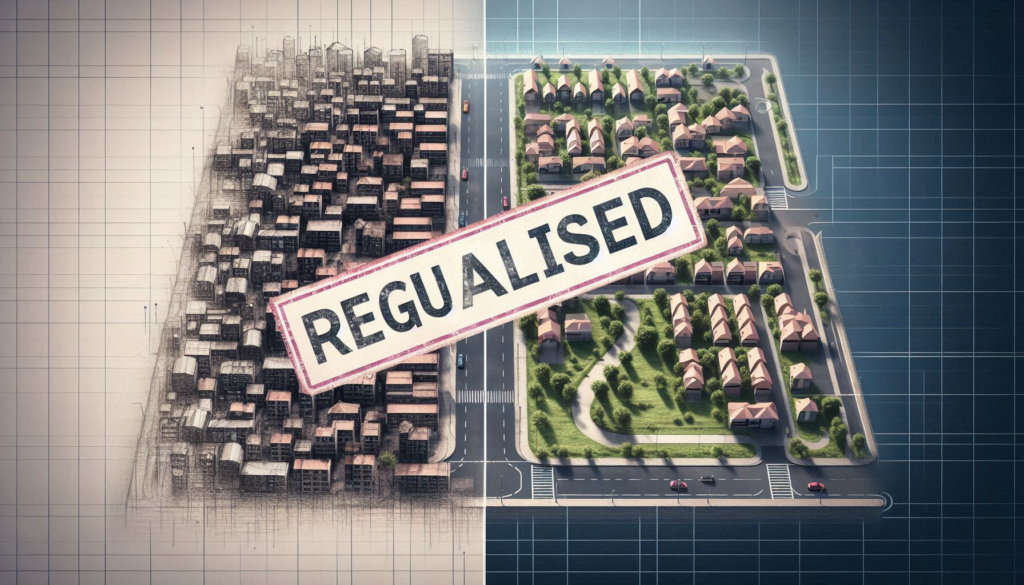In recent years, the issue of unapproved plots has become a significant concern for both property owners and urban planners. The process of unapproved plots regularisation has gained traction as a solution to bring these properties into compliance with local regulations.
This article will delve deep into the intricacies of unapproved plots regularisation, exploring the fees for regularisation of unapproved plots, and providing guidance on how to apply for plot regularisation.
Understanding Unapproved Plots Regularisation
Unapproved plots regularisation is a process designed to bring unauthorized or illegally developed land parcels into compliance with local zoning and planning regulations. This initiative aims to address the challenges posed by unplanned urban growth and ensure that all properties meet the necessary legal and safety standards.
The Importance of Unapproved Plots Regularisation
Unapproved plots regularisation serves several crucial purposes:
- Legal Compliance: It brings properties into alignment with local laws and regulations.
- Infrastructure Development: It allows for the proper planning and implementation of essential services.
- Property Value: Regularized plots often see an increase in market value.
- Urban Planning: It contributes to more organized and sustainable urban development.
The Process of Unapproved Plots Regularisation
The unapproved plots regularisation process typically involves several steps and can vary depending on the specific regulations of the area. Here’s a general overview of the process:
1. Identification of Unapproved Plots
Local authorities identify plots that have been developed without proper approvals or in violation of existing regulations.
2. Application for Regularisation
Property owners must submit an application for unapproved plots regularisation to the relevant authorities. This step is crucial in initiating the process.
3. Document Verification
Officials review the submitted documents to verify ownership and assess the plot’s current status.
4. Site Inspection
A physical inspection of the property is conducted to evaluate its compliance with local building codes and regulations.
5. Calculation of Fees for Regularisation of Unapproved Plots
Based on various factors, including plot size and location, the fees for regularisation of unapproved plots are calculated.
6. Payment of Regularisation Charges
Property owners must pay the determined fees for regularisation of unapproved plots to proceed with the process.
How to Apply for Plot Regularisation
Knowing how to apply for plot regularisation is essential for property owners seeking to bring their unapproved plots into compliance. Here’s a step-by-step guide:
- Gather Required Documents: Collect all necessary paperwork, including property deeds, tax receipts, and identity proofs.
- Fill Out the Application Form: Complete the official application form for unapproved plots regularisation, ensuring all details are accurate.
- Submit the Application: File the application along with the required documents to the designated authority.
- Pay Initial Fees: There may be initial processing fees associated with how to apply for plot regularisation.
- Await Inspection: Be prepared for a site visit by local officials as part of the unapproved plots regularisation process.
- Respond to Queries: Address any additional information requests or clarifications promptly.
- Pay Regularisation Fees: Once approved, pay the fees for regularisation of unapproved plots as calculated by the authorities.
Fees for Regularisation of Unapproved Plots
Understanding the fees for regularisation of unapproved plots is crucial for property owners embarking on this process. The cost structure for unapproved plots regularisation can vary based on several factors:
Factors Affecting Regularisation Fees
- Plot Size: Larger plots generally incur higher fees.
- Location: Prime areas may have higher regularisation charges.
- Land Use: Residential, commercial, or industrial use can affect the fee structure.
- Extent of Violation: The degree of deviation from approved plans may impact the fees.
Typical Fee Components
The fees for regularisation of unapproved plots often include:
- Basic Regularisation Charge
- Development Charges
- Open Space Reservation (OSR) Charges
- Infrastructure Development Fees
It’s important to note that these fees can vary significantly between different municipalities and states. Always check with local authorities for the most up-to-date information on fees for regularisation of unapproved plots.

Benefits of Unapproved Plots Regularisation
Engaging in the unapproved plots regularisation process offers several advantages to property owners:
- Legal Security: Regularised plots provide legal protection and reduce the risk of future disputes.
- Access to Services: Regularised properties are eligible for official utility connections and municipal services.
- Increased Property Value: Compliance with regulations often leads to an appreciation in property value.
- Easier Transactions: Regularised plots are easier to sell, mortgage, or transfer.
- Peace of Mind: Owners of regularised plots can avoid penalties and legal complications associated with unapproved properties.
Challenges in Unapproved Plots Regularisation
While the benefits are significant, the unapproved plots regularisation process can present some challenges:
1. Complex Procedures
Navigating the bureaucratic process of unapproved plots regularisation can be complicated and time-consuming.
2. High Costs
The fees for regularisation of unapproved plots can be substantial, potentially causing financial strain for some property owners.
3. Strict Deadlines
Many regularisation schemes have specific timeframes, and missing these deadlines can result in penalties or ineligibility.
4. Compliance Issues
Some properties may require significant modifications to meet regularisation standards, adding to the overall cost and complexity.
The Impact of Unapproved Plots Regularisation on Urban Development
Unapproved plots regularisation has far-reaching effects on urban landscapes and communities:
1. Improved Infrastructure
As part of the regularisation process, areas with previously unapproved plots often see improvements in roads, drainage, and other essential infrastructure.
2. Better Urban Planning
Regularisation allows city planners to incorporate these areas into broader urban development strategies.
3. Economic Benefits
The formalisation of these properties can lead to increased property tax revenues for local governments, funding further development.
4. Community Development
Regularised areas often see an influx of public services and amenities, improving the quality of life for residents.
How to Apply for Plot Regularisation: A Detailed Guide
Understanding how to apply for plot regularisation is crucial for property owners. Here’s an expanded guide to help navigate the process:
1. Research Local Regulations
Before initiating the application process, familiarize yourself with the specific unapproved plots regularisation rules in your area.
2. Collect Necessary Documents
Gather all required paperwork, which typically includes:
- Property ownership documents
- Tax receipts
- Survey numbers
- Existing building plans (if any)
- Identity proofs
3. Fill Out the Application Form
Obtain the official application form for unapproved plots regularisation from your local municipal office or download it from the official website.
4. Prepare a Site Plan
Create or hire a professional to draw up a detailed site plan showing the plot’s dimensions, built-up area, and surrounding properties.
5. Submit the Application
File your completed application along with all necessary documents and the site plan to the designated authority.
6. Pay Initial Processing Fees
Most jurisdictions require an initial fee to process your unapproved plots regularisation application.
7. Schedule and Prepare for Inspection
Officials will likely need to inspect your property. Ensure all areas are accessible and that you’re available to answer any questions.
8. Respond to Queries
Be prepared to provide additional information or clarifications as requested by the regularisation authorities.
9. Review Regularisation Terms
Once your application is processed, you’ll receive the terms for regularisation, including the fees for regularisation of unapproved plots.
10. Pay Regularisation Fees
Upon agreeing to the terms, pay the specified fees for regularisation of unapproved plots.
11. Receive Regularisation Certificate
After completing all steps and paying the required fees, you’ll receive an official regularisation certificate for your plot.
The Future of Unapproved Plots Regularisation
As urban areas continue to expand, the issue of unapproved plots remains a significant challenge for city planners and local governments. The future of unapproved plots regularisation is likely to see several developments:
1. Stricter Enforcement
Expect to see more rigorous enforcement of building codes and zoning laws to prevent the proliferation of unapproved plots.
2. Technology Integration
The use of GIS mapping and satellite imagery may streamline the process of identifying and regularising unapproved plots.
3. Sustainable Development Focus
Future regularisation schemes may place greater emphasis on environmental sustainability and green building practices.
4. Simplified Procedures
There may be efforts to streamline the unapproved plots regularisation process, making it more accessible to property owners.
5. Regular Regularisation Drives
Cities might conduct regular regularisation drives to keep pace with urban expansion and ensure compliance.
Unapproved Plots Regularisation: Case Studies
To better understand the real-world impact of unapproved plots regularisation, let’s look at some case studies:
Case Study 1: Successful Large-Scale Regularisation
In a rapidly growing suburb, local authorities implemented a comprehensive unapproved plots regularisation scheme. Over 5,000 plots were brought into compliance within a year, resulting in significant improvements to local infrastructure and a 30% increase in property values.
Case Study 2: Challenges in Historical Areas
An old town faced unique challenges in implementing unapproved plots regularisation due to the historical nature of many properties. The process required careful negotiation between preservation needs and modern compliance standards.
Case Study 3: Innovative Funding Approach
One municipality introduced a tiered payment system for fees for regularisation of unapproved plots, allowing property owners to pay in installments. This approach significantly increased participation in the regularisation program.

Expert Opinions on Unapproved Plots Regularisation
To provide a well-rounded view of unapproved plots regularisation, let’s consider some expert opinions:
Urban Planner’s Perspective
“Unapproved plots regularisation is a necessary step towards sustainable urban development. It allows cities to bring informal settlements into the formal planning framework, improving overall urban design and functionality.”
Legal Expert’s View
“While unapproved plots regularisation offers a path to compliance, it’s crucial that these schemes don’t inadvertently encourage future violations. Balancing amnesty with deterrence is key.”
Property Developer’s Insight
“The regularisation process, though sometimes costly, ultimately benefits both property owners and developers. It creates a more stable and predictable real estate market.”
Environmental Scientist’s Concern
“As we regularise unapproved plots, we must ensure that environmental considerations are not overlooked. Sustainable development practices should be an integral part of any regularisation scheme.”
Conclusion
Unapproved plots regularisation is a complex but necessary process in urban development. It offers a path to compliance for property owners while helping cities manage growth more effectively. Understanding how to apply for plot regularisation and navigating the fees for regularisation of unapproved plots are crucial steps for anyone involved in this process.
As urban areas continue to expand, the importance of unapproved plots regularisation will only grow. It represents a critical tool in creating more organized, sustainable, and livable cities. While challenges remain, the benefits of bringing unapproved plots into the formal urban framework are clear.
We encourage readers to share their experiences or questions about unapproved plots regularisation in the comments below. Your insights could be valuable to others navigating this complex process.
